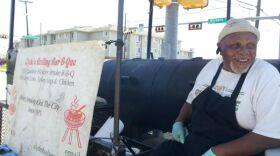Not long ago, Downtown Plano was a sleepy, nearly forgotten commercial center, where locals believed only the elderly shopped for antiques. Today, the historic square looks, and sounds, starkly different.
Dibe Khromachou is a culinary arts student, who just turned 21. On a typical Friday night, she's drinking with friends at the Fillmore Pub, which opened in 2011. The pub reminds her of something out of New York or Austin. She lives in Frisco but spends as much time as she can in Downtown Plano.
“I grew up knowing the soccer moms, the mega-malls and the chain restaurants,” she said.
Since the DART station opened in 2002, this downtown has added 70,000 square feet of retail space and more than 1,000 urban-style apartments. The population has grown from 775 people to nearly 1,800. Khromachou said the parking lots are full most nights and the cobbled sidewalks are crowded with young professionals, flitting from bar to bar.
“It’s never going to be where you won’t have to use cars. You’ll still have neighborhoods and malls and stuff,” she said. “But these new places make it easier for me to at least feel that I’m not living in the suburbs.”
City life in suburbia
Downtown Plano’s just one example of a national trend of walkable suburbs--using the tenets of “new urbanism.” Doug McDonald’s a Senior Planner for the City of Plano. He said the changes are driven largely by the influx of young people.
“There’s a need for people that want to come together and associate with each other, and get involved with their city and do activities with their cities, with their neighbors,” he said.
According to a 2011 survey in the Complete Streets Design manual for North Texas, 88 percent of residents said they’d be willing to drive an extra five minutes to a location, if it meant they could walk once they were there.
Numbers like these are hard to ignore. Just stop by Downtown McKinney, where outposts from Dallas’s hip Bishop Arts District have set up shop--like Emporium Pies. Similar scenes are also buzzing in Frisco, at Watters Creek in Allen and in Grapevine.
While Texas suburbs have earned a reputation of quiet ordinariness, McDonald said they do offer some things the denser, urban cities can’t:
“Quality of life aspects--lower crime, better public schools and park systems.”
Not to mention cost. According to apartment market research firm, Axiometrics, the average rent for an apartment in Downtown Dallas is about $1,600. In Plano, a similar apartment goes for just over $900.
Sustaining the urban suburb
There are concerns, though, about this “new suburbanism.” Alan Mallach from the National Housing Institute worries these walkable, multi-use micro-villages aren’t sustainable--that hip millennials are unlikely to stay once they start having children of their own.
So then urban planners and developers have the challenge of not only building these neighborhoods, but making them last.
Neal Sleeper is the President of CityPlace, the firm responsible for much of Uptown Dallas. He said mixing national and local retailers with green space, and staying away from large parking lots, is what makes walkability work.
“You want to create an environment where people like to walk and they like to walk because of what they see,” Sleeper said.
All 22-year-old Marissah Swift did was walk while getting ready to move to Downtown Plano. Three years ago, the Rockwall-native strolled from store to store getting to know the locals. She fell in love instantly.
“It’s younger, hipper. It’s definitely more fun,” she said. ”Everyone’s different, and everyone’s accepting toward one another. Everyone’s just comfortable with being around each other.”
With at least 1,000 more housing units in the works in downtown Plano, Swift said she’s excited to see new people continue to transform her neighborhood.








